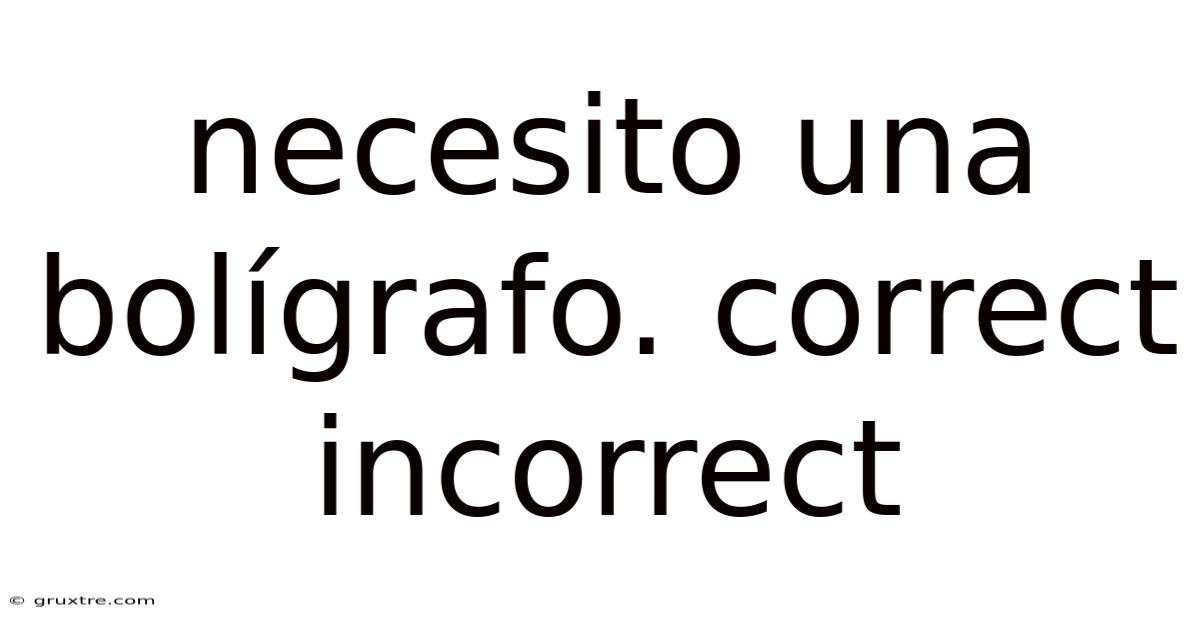Necesito Una Bolígrafo. Correct Incorrect
gruxtre
Sep 23, 2025 · 4 min read

Table of Contents
"Necesito un bolígrafo": Correcting Common Spanish Mistakes and Mastering Everyday Phrases
Many learners of Spanish encounter challenges with seemingly simple phrases. One such example is the phrase "Necesito una bolígrafo," which is commonly used but grammatically incorrect. This article will delve into the correct usage, explain the grammatical error, and explore related phrases to enhance your understanding of Spanish grammar and conversational fluency. We'll unpack the nuances of gender agreement in Spanish nouns, explore the correct usage of "necesitar," and provide a broader context for using this phrase in daily life.
Understanding the Error: Gender Agreement in Spanish
The mistake in "Necesito una bolígrafo" lies in the gender agreement between the article ("una," meaning "a") and the noun ("bolígrafo," meaning "pen"). In Spanish, nouns have a grammatical gender, either masculine or feminine. This gender affects the articles, adjectives, and pronouns that accompany them.
- Bolígrafo is a masculine noun. Therefore, the correct indefinite article to use is "un," not "una."
The correct phrase is: "Necesito un bolígrafo."
"Necesito" and its Usage: Expressing Needs
The verb "necesitar" means "to need" in English. It's a very common and versatile verb used to express various needs, from essential requirements to less urgent desires. Understanding its conjugation is crucial for accurate sentence construction.
Here's a quick conjugation of "necesitar" in the present tense:
- Yo necesito: I need
- Tú necesitas: You need (informal singular)
- Él/Ella/Usted necesita: He/She/You need (formal singular)
- Nosotros necesitamos: We need
- Vosotros necesitáis: You need (informal plural - used in some Spanish-speaking regions)
- Ellos/Ellas/Ustedes necesitan: They/You need (plural)
Expanding Your Vocabulary: Related Phrases and Expressions
Knowing just "Necesito un bolígrafo" is a good start, but mastering Spanish requires a broader vocabulary and understanding of related expressions. Here are some useful phrases that build upon this foundation:
- Necesito un lápiz: I need a pencil. (Lápiz is also masculine)
- Necesito papel: I need paper. (Papel is masculine)
- Necesito un cuaderno: I need a notebook. (Cuaderno is masculine)
- Necesito una goma de borrar: I need an eraser. (Goma de borrar is feminine)
- Necesito un sacapuntas: I need a pencil sharpener. (Sacapuntas is masculine)
- Necesito algo para escribir: I need something to write with. (A more general phrase)
- ¿Necesitas algo más?: Do you need anything else? (A useful question in various contexts)
- No necesito nada más, gracias: I don't need anything else, thank you. (A polite response)
- ¿Tienes un bolígrafo que pueda usar?: Do you have a pen I can use? (A polite request)
- Puedo usar tu bolígrafo?: Can I use your pen? (A direct request)
Beyond the Basics: Mastering Spanish Grammar
The correct use of "un" and "una" highlights a fundamental aspect of Spanish grammar: gender agreement. It's essential to learn the gender of nouns to avoid grammatical errors. There are no hard and fast rules to determine gender; it's largely based on memorization.
- Masculine Nouns: Often end in -o, but not always.
- Feminine Nouns: Often end in -a, but not always.
- Exceptions: Many nouns defy these general rules. The best way to learn is through practice and exposure to the language.
Practical Applications: Using "Necesito un bolígrafo" in Real-Life Situations
The phrase "Necesito un bolígrafo" is useful in various daily situations:
- In a classroom: You might say this to your teacher if you've forgotten your pen.
- In an office: If you need a pen to sign a document.
- In a store: To ask for a pen if you need to fill out a form.
- At home: If you can't find your pen.
Frequently Asked Questions (FAQ)
Q: How do I learn the gender of Spanish nouns?
A: The best approach is through immersion and memorization. Use flashcards, language learning apps, and practice writing sentences. Pay attention to the articles used with nouns you encounter.
Q: Are there any tricks to remember the gender of nouns?
A: While there are no foolproof tricks, focusing on common patterns (nouns ending in -o being masculine, and nouns ending in -a being feminine) can be helpful. However, always check a dictionary or reliable resource to confirm.
Q: What happens if I use the wrong gender agreement?
A: While native speakers usually understand the intended meaning, using the incorrect gender shows a lack of grammatical understanding, and it can sound unnatural to a native ear.
Q: Is there a way to avoid making mistakes with gender agreement?
A: Consistent practice, immersion, and careful attention to detail are key to mastering gender agreement. Don't be afraid to make mistakes; learning from them is crucial for improvement.
Conclusion: Mastering Spanish Through Practice and Persistence
Correctly saying "Necesito un bolígrafo" is a small step, but it's a significant step towards mastering Spanish. This simple phrase highlights the importance of gender agreement, a crucial aspect of Spanish grammar. By understanding this concept and expanding your vocabulary with related phrases, you will significantly improve your fluency and confidence in using Spanish in daily life. Remember, consistent practice and immersion are key to mastering any language. Don't be discouraged by mistakes; embrace them as learning opportunities. Keep practicing, keep learning, and soon you'll be confidently navigating everyday conversations in Spanish. The journey of language acquisition is rewarding, and each correctly formed sentence brings you closer to fluency.
Latest Posts
Latest Posts
-
Post Test Beginning A Journey
Sep 23, 2025
-
Mcgraw Hill Chapter 1 Answers
Sep 23, 2025
-
What Is A Verruca Milady
Sep 23, 2025
-
Acs Chem 2 Study Guide
Sep 23, 2025
-
Quiz Title Ix Student Training
Sep 23, 2025
Related Post
Thank you for visiting our website which covers about Necesito Una Bolígrafo. Correct Incorrect . We hope the information provided has been useful to you. Feel free to contact us if you have any questions or need further assistance. See you next time and don't miss to bookmark.